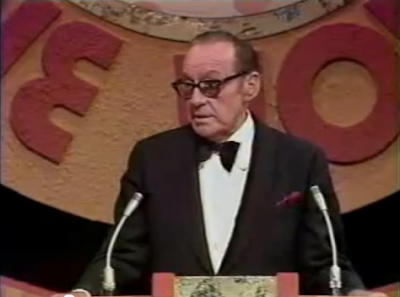The Associated Press interviewed Jack that year and his answers were assembled into a feature story that ran July 10th.
Jack Benny . . . The Non-Slowdown Comic
By MARY CAMPBELL
AP Newsfeatures Writer
NEW YORK (AP) — “Why are you going into a summer theater?” Jack Benny quotes his Beverly Hills doctor as asking him. “It can’t be for the money.”
Benny pauses for the inevitable laugh at his legendary stinginess, and continues, “So I said to my new doctor . . .”
At 71, looking 59 and saying he feels better than the many years when he was 39, blue-eyed Jack Benny has for the first time booked himself, “An Hour and 60 Minutes with Jack Benny,” (the hour a funny, rambling chat, the 60 minutes a combination of humor and violin playing) into a small theater, the Tappan Zee Playhouse in Nyack, N. Y.
“It’s so intimate,” he says. “The boxes are right close. I can talk to an audience like I'm talking to you.
“Of course I love the theater. If I had time this summer I’d continue to do it.”
But Benny doesn't have time. He arrived in New York from playing in Las Vegas and will go right back to the West Coast to perform at Lake Tahoe and do two hour-long TV shows. After that, there are shows in London, 10 or so benefit appearances with his Stradivarius with symphony orchestras in Arizona Texas and Florida, and then maybe he'll have time for more cozy theaters like the 792-seat Tappan Zee.
Intimate Revue Is New
Asked what else is new, Benny says, “What news could I give? I've been in the business now 100 years. Well, I’ve never done this before — an intimate revue.
“The only other new thing is if I found the right play on Broadway, I would do it. It would have to be something I was absolutely insane about. I’d want it to use any delivery but I wouldn’t want it to have anything to do with being stingy, and the Maxwell, etc. I wouldn’t want it to be too stylized, so it would only fit me and not anybody else.
“The best picture I ever made was ‘To Be or Not To Be.’ If I hadn't played it, some body else could have played it beautifully.
“If I ever made another film, I would want to make a film at my age like Chevalier, you know. Chevalier is very smart: Rock Hudson, Doris Day and Maurice Chevalier, playing the uncle, or the grandfather or the great-grandfather.”
For his “Hour and 60 Minutes,” Benny says, “Most of the material is new.
"I think the material has always been to a certain extent sophisticated. It has a human quality. It is about people, the frailties and faults of people, which I am supposed to have, you know. You have to have smart jokes, good sophisticated smart jokes. I think I’ve got them.
"My material usually doesn’t fit anybody else, therefore it isn't bandied around by a lot of people, you know. Certain routines that fit other people, they have taken. You know what I do?
“I always remember a thing Will Rogers said once when he was doing a show with Eddie Cantor. Cantor said, ‘I saw a fellow doing your whole act. Aren’t you going to do something about it?’ Rogers said, ‘Yes, I’m going to do new material for myself.’
Nicest Thing Ever
The comedian says that Jack Benny High School in his hometown, Waukegan, Ill., is “about the nicest thing that ever happened to me.
“They didn't just rename a school. They actually built it for me. I was there for the ground-breaking.
“And I never even graduated from high school. I was thrown out the first year, because I used to skip school all the time and practice my fiddle. The principal said, ‘Benny, we don't teach music here and I’m asking you to leave.’ So I walked out."
For nine years, Benny has been donating his services as guest violinist with various city’s symphonies, to benefit the orchestras or their pension funds.
“I love it,” he says. “I’m a frustrated violinist. I’m a comedian, and the greatest, most dignified, highest-class background that a comedian can have is to walk out in tails with a violin and have 100 of the finest musicians in back of you with a, Bernstein or a Steinberg or a Szell conducting, and I do what Heifetz does, but I'm a comedian.
“It doesn’t fit anybody else, except Danny Kaye, and he conducts the orchestra. If this fit eight other comedians, as nice and charitable as I'd like to be, I wouldn't like to do it.”
Mentioning the same subject at his Tappan Zee Playhouse opening night, he added, “The way I play, some people even yell bravo.”
Later in the show, Benny said he would like to introduce just one friend down front in the audience, Helen Hayes. She stood, acknowledged applause, and said to the man on the stage, “I’m the one who's been yelling bravo.”
























